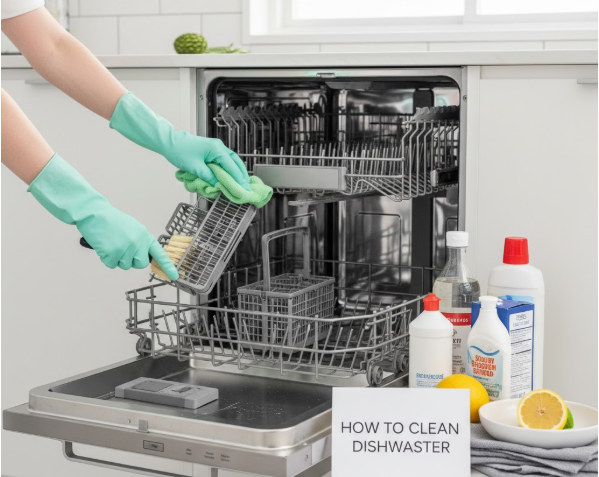How to Clean Dishwasher: A Friendly, Step-by-Step Guide
If you’ve ever wondered how to clean dishwasher so it runs well and doesn’t smell bad, you’re in the right place. Your dishwasher is your kitchen helper, but like any machine, it needs care and attention. In this guide you’ll find simple language, clear steps, and helpful pointers to keep your appliance fresh and working at its best.
Why You Need to Clean Your Dishwasher
Even though your dishwasher washes dishes for you, it still collects debris, mineral build-up and odor-causing bits over time. According to expert advice, debris like food particles or soap residues can cause poor cleaning results and unpleasant smells if overlooked. Also, if your home has hard water (common in many places), minerals build up inside the dishwasher and reduce its efficiency. Regular cleaning helps maintain performance and prolongs the life of the appliance. So learning and applying best way to clean dishwasheris more than just cosmetic — it’s practical care.
What You’ll Need Before You Start
Before diving into the cleaning process, set yourself up with a few items and prep steps:
-
Empty the dishwasher completely — no dishes inside. This allows you to reach all parts.
-
A measuring cup or dishwasher-safe container for adding vinegar if you choose that method.
-
White distilled vinegar, baking soda, or a specialized dishwasher cleaner. Many sources support vinegar + baking soda as an effective combo.
-
A soft cloth, old toothbrush (for tight spots), and perhaps a toothpick for spray head holes.
-
Your dishwasher’s manual handy — some models have special instructions or filter designs.
Having these ready makes the process smoother.
Step-by-Step: How to Clean Dishwasher Inside Out
1. Remove and clean the filter
One of the first steps when you learn how to clean dishwasher is to check the filter. Many dishwashers have a removable filter at the bottom. Food scraps, popcorn kernels, or small debris may collect there. Remove (if possible), rinse it under warm soapy water, scrub gently if needed, then replace. Even if the filter isn’t removable, wipe around it and make sure no big bits are stuck.
2. Clean the spray arms and interior parts
Your dishwasher’s spray arms rotate and spray water. If their holes are clogged, cleaning suffers. Use a toothpick or a small brush to clear holes in the arms, and wipe the interior walls and door gasket with a damp cloth and mild soap or vinegar solution. Also check the drain at the bottom — visible debris there should be removed to prevent smells or drainage issues.
3. Run a vinegar cycle
Now for a main cleaning cycle. If you ask how to clean dishwasher deeply, one of the most recommended methods is to place 1 cup to 2 cups of white distilled vinegar in a dishwasher-safe container (on the top rack) and run a normal hot water cycle with no detergent. This helps dissolve mineral build-up, soap scum, and deodorize.
4. Follow with baking soda (optional)
After the vinegar cycle ends, you can sprinkle about 1 cup of baking soda on the bottom of the empty dishwasher and run a short hot cycle. This step helps lift remaining stains and freshen the machine. Important: Do not mix vinegar and baking soda in the same cycle—they react, foam and may not get the same cleaning effect.
5. Wipe the door, gasket and exterior
While the interior cycle is underway (or afterwards), clean the door edges, seals/gasket, control panel and exterior. For stainless steel finishes, wipe in the direction of the grain to avoid streaks. Use a damp microfiber cloth and mild cleaner.
6. Leave it to air dry
Once the cleaning cycles are done, leave the dishwasher door slightly ajar to allow air drying. This helps prevent dampness and mold growth inside. Some sources recommend skipping the automatic drying cycle for the vinegar and baking soda cycle methods.
How Often Should You Clean?
If you’re wondering how to clean dishwasher on a schedule: the consensus from appliance manufacturers is monthly deep cleans if you use the machine regularly. For example, sources say every 30 days in homes with moderate use. If you live in an area with hard water or use the dishwasher heavily, you may want to do the deep clean more often. Conversely, at the very least, wipe down the filter and check for debris weekly.
Here’s a simple table to illustrate:
| Frequency | What to do |
|---|---|
| Weekly / every load | Remove obvious food debris, wipe out bottom & door seal |
| Monthly | Deep clean – filter, spray arms, vinegar or cleaner run |
| As needed | Exterior polish, check for odors, check drainage |
Common Mistakes to Avoid
Learning how to clean dishwasher well means also avoiding some common mistakes:
-
Using bleach on stainless steel interiors: Some guides warn against using bleach if your dishwasher has stainless steel components, because bleach may damage or discolor the finish.
-
Ignoring the filter: A clogged filter is a frequent cause of bad smells or dishes not coming out clean.
-
Using vinegar and baking soda together in the same cycle: As mentioned, this causes a reaction that may reduce the cleaning effect.
-
Leaving the door fully closed after runs: Without ventilation, dampness may lead to mold or mildew inside.
-
Assuming the dishwasher self-cleans: Even self-cleaning models benefit from manual checks and cleaning of small parts and seals.
Benefits of Cleaning Your Dishwasher Properly
By regularly following the steps of how to clean dishwasher, you gain several benefits:
-
Cleaner, fresher-smelling dishwasher: No nasty odors or leftover food bits stuck inside.
-
Better dish cleaning performance: When spray arms move freely and filters aren’t clogged, dishes come out cleaner.
-
Longer lifespan for your appliance: Less mineral build-up and lubrication problems means fewer repairs.
-
Energy and water savings: Efficient operation means you get better results with less waste.
-
Healthier kitchen environment: Reduces the chance of mold, mildew or bacterial build-up in your appliance.
Tips for Keeping Things Easy & Smooth
Here are some extra friendly tips to make your dishwasher cleaning routine easier:
-
After each cycle, open the door slightly to let steam escape.
-
Check that spray arms can spin full circle — sometimes heavy dishes block them.
-
Scrape large food particles off dishes before loading (but you often don’t need to rinse thoroughly).
-
Use a rinse-aid if you have hard water to reduce spots and mineral streaks.
-
Keep a microfiber cloth and soft brush near the dishwasher for quick spot cleaning.
-
Write a reminder on your calendar or phone to perform the monthly clean.
FAQ – Higher-Rank Questions
Q1: How long does the cleaning cycle take when you do a “how to clean dishwasher” run?
A1: Typically you run a normal wash cycle (which may be 1 hour or more) when using vinegar. Then the baking soda cycle may be shorter. The exact time depends on your appliance model.
Q2: Can I use bleach instead of vinegar to clean my dishwasher?
A2: Yes — if your dishwasher doesn’t have stainless steel interior or parts that bleach can harm. One source suggests pouring 1 cup of bleach into a safe bowl on the top rack and running a full cycle. But always check your manual first.
Q3: My dishwasher smells musty after a run. What part of “how to clean dishwasher” did I miss?
A3: The smell often comes from food trapped in the filter, drain area, spray arms or gasket. Empty the machine, remove debris, run a vinegar or cleaning tablet cycle and leave the door open to air dry. Make sure the filter is cleaned.
Q4: How do I clean the outside of my dishwasher?
A4: Use a damp microfiber cloth with mild soapy water. For stainless steel panels, wipe in the direction of the grain and then polish. Avoid abrasive cleaners which might scratch the surface.
Q5: I have hard water. Does that change how I should follow the “how to clean dishwasher” routine?
A5: Yes, in hard-water areas you may need to clean more often because mineral (lime) build-up happens faster. Also consider using dishwasher cleaner tablets designed for mineral removal, and use a rinse aid to help reduce layering of mineral residue.
Final Thoughts
Taking time to learn how to clean dishwasher properly is a smart move for any home. It may seem like an extra chore, but a little effort now saves you from bad odors, poorly cleaned dishes, and costly repairs later. Follow the steps, keep to the schedule, and your dishwasher will keep doing its job reliably — leaving you to focus on other parts of your kitchen and life. Make it a habit. Your clean dishes (and your nose) will thank you.


